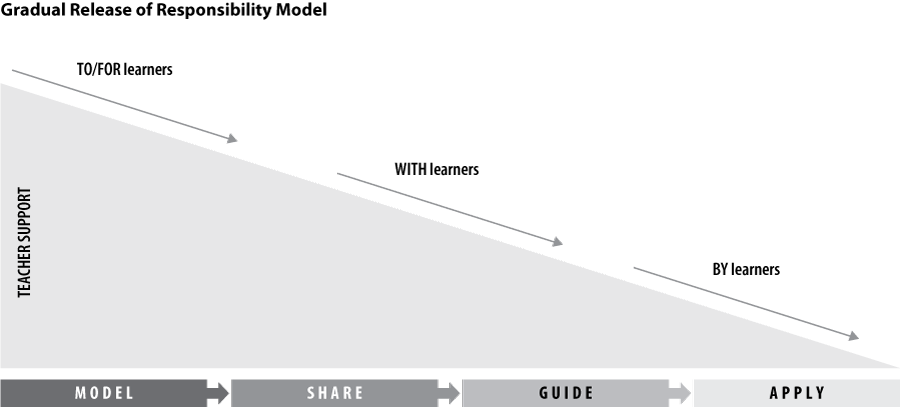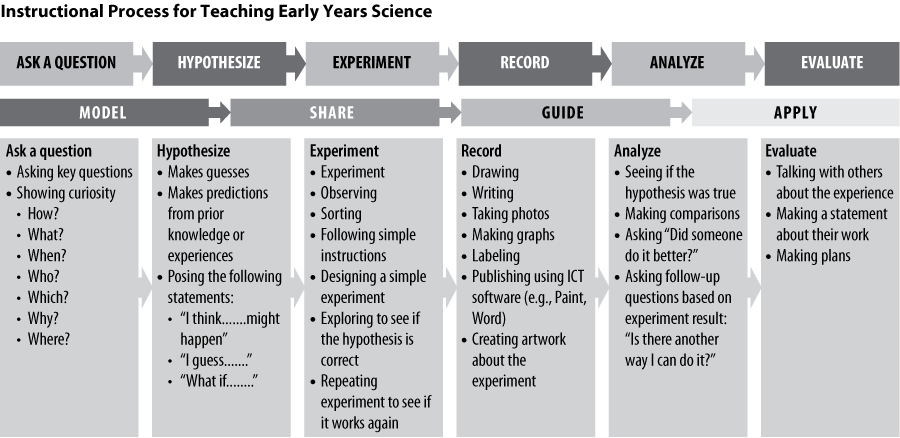Instruction for Mathematics and Science in Primary and Lower Secondary Grades
Grade at Which Specialist Teachers for Mathematics and Science are Introduced
In accordance with the Abu Dhabi School Model, teachers are required to provide effective instruction and follow-up support to every child, as he or she learns new concepts and skills. The Gradual Release of Responsibility Model, illustrated in Exhibits 1 to 4, reflects the ADEC’s new pedagogical approach, whereby teachers support the individual instructional needs of each child while enabling the child to progress gradually from dependent to independent practice and skills application.13 Each subject area requires a different type of thinking. The Gradual Release approach supports learners as they progress from teacher-directed learning to independent learning in every subject area.
Early Years (KG to Grade 5) students participate in “science in context” learning experiences, during which teachers apply the Gradual Release of Responsibility Model to ensure their students understand and learn to apply the scientific process. Science instruction is integrated into literacy and numeracy, and focuses on the scientific process to help students gain mastery and independence in science-based inquiry.14
Exhibit 1: Gradual Release of Responsibility Model

Exhibit 2: Gradual Release of Responsibility Model for Early Years Mathematics

Exhibit 3: Gradual Release of Responsibility Model for Early Years Science

Exhibit 4: Instructional Process for Teaching Early Years Science

Instructional Materials, Equipment, and Laboratories
The primary goal of learning resource centers (LRCs) is to build skills that enable students to become lifelong learners and readers who use information as a way to solve problems, act ethically, plan for the future, and prepare for change. These skills are developed through an instructional focus on information literacy. Information literacy is defined as the ability to acquire, critically evaluate, select, use, create, and communicate information in ways that lead to knowledge and understanding.
The ADEC has developed the Information Literacy Skills Framework to describe the progression of skills that students should build in each grade. This framework will be the focus of LRC leadership in all schools.
In ADEC schools, the learning expectations that are established for English and Arabic language development include many of the skills and expectations that are included in the Information Literacy Skills Framework.
Teachers and LRC specialists work in coordination with each other, with a focus on integrating the use of the LRC into overall literacy instruction for all students. Teachers integrate time in the LRC and use of LRC resources into the planning of lessons that are aligned with the ADEC curriculum. Teachers also coordinate with LRC specialists in assessing the progress of students toward meeting learning outcomes in literacy. LRC specialists work with teachers and heads of faculty to identify and plan opportunities for integration between LRCs and literacy instruction in both Arabic and English.15
Use of Technology
e-Learning is an essential part of the delivery of the ADEC curriculum, and is to be used to innovate both teaching and learning. e-Learning is defined as teaching and learning empowered by electronic technology. It supports and enables student-centered learning experiences that are flexible, collaborative, interactive, engaging, and authentic.
All teachers should seek to integrate e-learning into teaching and learning across subjects, with the support of eLearning teachers in grades beginning in Cycle 1. The ADEC has established guidelines and procedures to ensure appropriate use of technologies, including a code of conduct, security provisions, and use of online resources.16
Accommodation Policies for Instruction and Testing
In ADEC schools, assessment is central to teaching and learning. Successful implementation of the ADEC curriculum will require an understanding of the purpose of student assessment and a specific approach to how assessment is conducted and utilized in the classroom.
Continuous assessment (CA) is a pedagogical approach that uses a variety of techniques to assess how students are learning. Continuous assessment activities may include, but are not limited to, student assignments, research, presentations, reports, quizzes, tests, and practical activities. CA activities measure student performance relative to established learning outcomes, and provide teachers with data to guide their planning of classroom instruction.
The ADEC curriculum requires the use of continuous assessment to inform teaching and facilitate learning. The ADEC has developed CA models and frameworks for all subjects in Kindergarten to Grade 11. Teachers in those grades are expected to use the Student Assessment Record (StAR) to record all CA assessment data. Grade 12 CA models follow Ministry of Education regulations and guidelines.
Classroom teachers are responsible for developing additional authentic tasks and conducting continuous assessment, with the support of principals, academic vice principals, and heads of faculty. Assessing student progress and planning instructional strategies linked to assessments are core responsibilities of teachers in ADEC schools.17
